メニュー
JP | JPY
-
-
-
- Challenges and Chances: A Review of the 1st Stem Cell Community Day
- Summertime, and the Livin’ Is Easy…
- Follow-on-Biologics – More than Simple Generics
- Bacteria Versus Body Cells: A 1:1 Tie
- Behind the Crime Scene: How Biological Traces Can Help to Convict Offenders
- Every 3 Seconds Someone in the World Is Affected by Alzheimer's
- HIV – It’s Still Not Under Control…
- How Many Will Be Convicted This Time?
- Malaria – the Battle is Not Lost
- Physicians on Standby: The Annual Flu Season Can Be Serious
- At the Forefront in Fighting Cancer
- Molecular Motors: Think Small and yet Smaller Again…
- Liquid Biopsy: Novel Methods May Ease Cancer Detection and Therapy
- They Are Invisible, Sneaky and Disgusting – But Today It’s Their Special Day!
- How Many Cells Are in Your Body? Probably More Than You Think!
- What You Need to Know about Antibiotic Resistance – Findings, Facts and Good Intentions
- Why Do Old Men Have Big Ears?
- The Condemned Live Longer: A Potential Paradigm Shift in Genetics
- From Research to Commerce
- Chronobiology – How the Cold Seasons Influence Our Biorhythms
- Taskforce Microbots: Targeted Treatment from Inside the Body
- Eyes on Cancer Therapy
-
-
-
-
-
- Challenges and Chances: A Review of the 1st Stem Cell Community Day
- Summertime, and the Livin’ Is Easy…
- Follow-on-Biologics – More than Simple Generics
- Bacteria Versus Body Cells: A 1:1 Tie
- Behind the Crime Scene: How Biological Traces Can Help to Convict Offenders
- Every 3 Seconds Someone in the World Is Affected by Alzheimer's
- HIV – It’s Still Not Under Control…
- How Many Will Be Convicted This Time?
- Malaria – the Battle is Not Lost
- Physicians on Standby: The Annual Flu Season Can Be Serious
- At the Forefront in Fighting Cancer
- Molecular Motors: Think Small and yet Smaller Again…
- Liquid Biopsy: Novel Methods May Ease Cancer Detection and Therapy
- They Are Invisible, Sneaky and Disgusting – But Today It’s Their Special Day!
- How Many Cells Are in Your Body? Probably More Than You Think!
- What You Need to Know about Antibiotic Resistance – Findings, Facts and Good Intentions
- Why Do Old Men Have Big Ears?
- The Condemned Live Longer: A Potential Paradigm Shift in Genetics
- From Research to Commerce
- Chronobiology – How the Cold Seasons Influence Our Biorhythms
- Taskforce Microbots: Targeted Treatment from Inside the Body
- Eyes on Cancer Therapy
-
-
JP | JPY

Influence of Physical Parameters on the Dispensed Volume of Air-Cushion Pipette
生命科学の探究
- メンテナンスとキャリブレーション
- ピペッティング技術
- エッセー
- 心を動かすサイエンス
The surrounding in the laboratory e.g., humidity, altitude and temperature, as well as the liquid properties of a sample itself like viscosity, volatility or density have a tremendous influence on the pipetting result. Each factor influences the pipetting volume and with this the experimental result in a different way. So a liquid temperature other than 22 °C already leads to less or excessive volume delivery. Or a dense liquid like phosphoric acid leads to constant insufficient liquid volume. All factors have to be considered during daily pipetting tasks and especially during calibration of a pipette. So consider our recommendations to improve your daily pipetting work.
Impact on the systematic accuracy of a pipette with liquid densities deviating from the density of water. When using dense liquids the pipette needs to be adjusted for proper volume delivery.
もっと読む
表示を減らす

Liquid temperatures other than 22 °C lead to systematic measurement deviations if forward pipetting technique is performed. Therefore another pipetting technique like reverse pipetting or a different pipette type like a direct replacement system should be considered.
もっと読む
表示を減らす

Pipettes are calibrated to an altitude of 0 m sea level. Different altitudes lead to higher systematic errors and can only be beaten by a permanent adjustment of the pipette.
もっと読む
表示を減らす

If you want to read more about the influence of physical parameters on the dispensed volume of air-cushion pipette, please download our Userguide!
もっと読む
表示を減らす

